Graphene Nanoplatelets Suspended in Different Basefluids Based Solar Collector: An Experimental and Analytical Study
Abstract
1. Introduction
2. Methodology
2.1. Preparation Method and Characterization
2.2. Density and Specific Heat Capacity Measurements
- (i).
- Solid NPs: DM40-density meter (Mettler Toledo, Columbus, OH, USA) to determine densities and Linseis’ differential scanning calorimeter (1000-/C) to determine specific heats with a temperature range of −50 °C to 550 °C;
- (ii).
- Base fluids: densities and specific heats were obtained from the National Institute of Standards and Technology (NIST);
- (iii).
- f-GNPs nanofluids: densities and specific heats were determined using the equations reported by Pak and Cho [27].
2.3. Theoretical Approach and MATLAB
2.4. Data Processing
3. Results and Discussion
3.1. Thermal Analysis
3.2. Stability and Morphological Analysis
3.3. Thermal Performance of Nanofluids
4. Conclusions
- The UV–VIS spectra showed a sharp absorption peak at a wavelength of ~283. In the temperature range of 500–800 °C, f-GNPs suffered from a weight loss of nearly 24%, which was attributable to the breakdown of the air’s graphitic carbon nanostructures.
- The zeta potential of the prepared f-GNPs had a negative charge of −39.4 mV. The EDX analyses of the GNPs confirmed its high carbon content of 88.95% and lower atomic oxygen content of 10.94%. The atomic contents of Si, S, and Zr were 0.05%, 0.05%, and 0.01%, respectively.
- The zero-loss efficiency at a flow rate of 1.5 kg min−1 was 0.6992, 0.7038, and 0.7026 for EG, DW: EG (70:30), and DW: EG (50:50), respectively. This means that the increased flow rate improved the performance of the collector. FR (τα) and FRUL increased in tandem, with the flow rate increasing from 0.5 to 1.5 kg min−1.
- At a flow rate of 1.5 kg min−1, the efficiency enhancements were 8.15%, 9.53%, 11.90%, and 12.69% for the EG-based f-GNPs nanofluids with multiple weight concentrations, respectively, while the enhancements were 8.09%, 9.46%, 11.82%, and 12.60% for the DW:EG (70:30)-based f-GNPs nanofluids for multiple weight concentrations, respectively. The enhancements were 8.11%, 9.48%, 11.84%, and 12.62% for the DW:EG (50:50)-based f-GNPs nanofluids in the case of multiple weight concentrations, respectively. The results revealed that GNPs-based basefluids could function as a kind of good and alternative conventional working fluid in heat transfer applications.
- At a flow rate of 1.5 kg min−1 and 0.1 wt %, FR(τα) and FRUL increased by 12.48% and 34.25%, 12.40% and 34.01, 12.42% and 34.08% for the EG, DW:EG (70:30)-based, and DW:EG (50:50)-based f-GNPs nanofluids, respectively.
Author Contributions
Funding
Institutional Review Board Statement
Informed Consent Statement
Data Availability Statement
Conflicts of Interest
Nomenclature and Abbreviations
| Ac | surface area of collector, m2 |
| Al2O3 | aluminium oxide |
| CNTs | carbon nanotubes |
| Cp | specific heat coefficient, kJ kg−1 K−1 |
| CuO | copper oxide |
| DASC | direct absorption solar collector |
| DSC | differential scanning calorimetry |
| DW | distilled water |
| EDX | energy dispersive X-ray |
| EG | ethylene glycol |
| ELS | electrophoretic light scattering |
| FPSC | flat plate solar collector |
| FR(τα) | collector heat gain coefficient |
| FRUL | collector heat loss coefficient |
| GNPs | graphene nanoplatelets |
| GO | graphene oxide |
| Gr | graphene |
| GT | global solar radiation, W m−2 |
| hw | heat transfer coefficient of wind, W m−2 K−1 |
| HR-TEM | high-resolution transmission electron microscopy |
| HTFs | heat transfer fluids |
| K | thermal conductivity, W m−1 K−1 |
| L | characteristic length, m |
| Fluid mass flow rate, kg min−1 | |
| MWCNTs | multiwalled carbon nanotubes |
| N | number of glasses |
| PCM | phase change material |
| PDI | polydispersity index |
| Qloss | overall heat loss, W |
| Qu | rate of useful energy gained, W |
| SEM | scanning electron microscopy |
| SiO2 | silicon dioxide |
| SWCNTs | single-wall carbon nanotubes |
| T | temperature, K |
| TGA | thermogravimetric analysis |
| TiO2 | titanium oxide |
| UL | overall loss coefficient of an FPSC, W m−2 K−1 |
| Greek Letters | |
| εg | glass cover emittance |
| εap | absorber plate emittance |
| η | collector efficiency |
| ρ | working fluid density, kg m−3 |
| σ | Stefan–Boltzmann constant, W m−2 K−4 |
| τα | absorptance–transmittance product |
| φ | weight percentage, wt % |
| Subscripts | |
| amb | room temperature |
| b | back-side |
| bf | base fluid |
| c | collector |
| e | edge-side |
| fm | mean fluid |
| In | input |
| Nf | nanofluid |
| Np | nanoparticle |
| out | output |
| Pm | mean absorber plate |
| T | top-side |
References
- Khanafer, K.; Vafai, K. A review on the applications of nanofluids in solar energy field. Renew. Energy 2018, 123, 398–406. [Google Scholar] [CrossRef]
- Elsheikh, A.; Sharshir, S.; Mostafa, M.E.; Essa, F.; Ali, M.K.A. Applications of nanofluids in solar energy: A review of recent advances. Renew. Sustain. Energy Rev. 2018, 82, 3483–3502. [Google Scholar] [CrossRef]
- Aleksiejuk-Gawron, J.; Chochowski, A. Study of Dynamics of Heat Transfer in the Flat-Plate Solar Collector. Processes 2020, 8, 1607. [Google Scholar] [CrossRef]
- Obstawski, P.; Bakoń, T.; Czekalski, D. Comparison of Solar Collector Testing Methods—Theory and Practice. Processes 2020, 8, 1340. [Google Scholar] [CrossRef]
- Duffie, J.A.; Beckman, W.A.; Worek, W.M. Solar Engineering of Thermal Processes, 4nd ed. J. Sol. Energy Eng. 1994, 116, 67–68. [Google Scholar] [CrossRef]
- Ladjevardi, S.; Asnaghi, A.; Izadkhast, P.; Kashani, A. Applicability of graphite nanofluids in direct solar energy absorption. Sol. Energy 2013, 94, 327–334. [Google Scholar] [CrossRef]
- Phelan, P.; Otanicar, T.; Taylor, R.A.; Tyagi, H. Trends and Opportunities in Direct-Absorption Solar Thermal Collectors. J. Therm. Sci. Eng. Appl. 2013, 5, 021003. [Google Scholar] [CrossRef]
- Solangi, K.; Kazi, S.; Luhur, M.; Badarudin, A.; Amiri, A.; Sadri, R.; Zubir, M.N.M.; Gharehkhani, S.; Teng, K. A comprehensive review of thermo-physical properties and convective heat transfer to nanofluids. Energy 2015, 89, 1065–1086. [Google Scholar] [CrossRef]
- Ganvir, R.; Walke, P.; Kriplani, V. Heat transfer characteristics in nanofluid—A review. Renew. Sustain. Energy Rev. 2017, 75, 451–460. [Google Scholar] [CrossRef]
- Zayed, M.; Zhao, J.; Du, Y.; Kabeel, A.; Shalaby, S. Factors affecting the thermal performance of the flat plate solar collector using nanofluids: A review. Sol. Energy 2019, 182, 382–396. [Google Scholar] [CrossRef]
- Raj, P.; Subudhi, S. A review of studies using nanofluids in flat-plate and direct absorption solar collectors. Renew. Sustain. Energy Rev. 2018, 84, 54–74. [Google Scholar] [CrossRef]
- Yousefi, T.; Veysi, F.; Shojaeizadeh, E.; Zinadini, S. An experimental investigation on the effect of Al2O3–H2O nanofluid on the efficiency of flat-plate solar collectors. Renew. Energy 2012, 39, 293–298. [Google Scholar] [CrossRef]
- Yousefi, T.; Veisy, F.; Shojaeizadeh, E.; Zinadini, S. An experimental investigation on the effect of MWCNT-H2O nanofluid on the efficiency of flat-plate solar collectors. Exp. Therm. Fluid Sci. 2012, 39, 207–212. [Google Scholar] [CrossRef]
- Yousefi, T.; Shojaeizadeh, E.; Veysi, F.; Zinadini, S. An experimental investigation on the effect of pH variation of MWCNT–H2O nanofluid on the efficiency of a flat-plate solar collector. Sol. Energy 2012, 86, 771–779. [Google Scholar] [CrossRef]
- Faizal, M.; Saidur, R.; Mekhilef, S. Potential of size reduction of flat-plate solar collectors when applying MWCNT nanofluid. In Proceedings of the IOP Conference Series: Earth and Environmental Science, 4th International Conference on Energy and Environment 2013 (ICEE 2013), Putrajaya, Malaysia, 5–6 March 2013. [Google Scholar]
- Said, Z.; Saidur, R.; Rahim, N.; Alim, M. Analyses of exergy efficiency and pumping power for a conventional flat plate solar collector using SWCNTs based nanofluid. Energy Build. 2014, 78, 1–9. [Google Scholar] [CrossRef]
- Said, Z.; Saidur, R.; Sabiha, M.; Rahim, N.; Anisur, M. Thermophysical properties of Single Wall Carbon Nanotubes and its effect on exergy efficiency of a flat plate solar collector. Sol. Energy 2015, 115, 757–769. [Google Scholar] [CrossRef]
- Vakili, M.; Hosseinalipour, S.; Delfani, S.; Khosrojerdi, S.; Karami, M. Experimental investigation of graphene nanoplatelets nanofluid-based volumetric solar collector for domestic hot water systems. Sol. Energy 2016, 131, 119–130. [Google Scholar] [CrossRef]
- Ahmadi, A.; Ganji, D.D.; Jafarkazemi, F. Analysis of utilizing Graphene nanoplatelets to enhance thermal performance of flat plate solar collectors. Energy Convers. Manag. 2016, 126, 1–11. [Google Scholar] [CrossRef]
- Vincely, D.A.; Natarajan, E. Experimental investigation of the solar FPC performance using graphene oxide nanofluid under forced circulation. Energy Convers. Manag. 2016, 117, 1–11. [Google Scholar] [CrossRef]
- Verma, S.K.; Tiwari, A.K.; Chauhan, D.S. Experimental evaluation of flat plate solar collector using nanofluids. Energy Convers. Manag. 2017, 134, 103–115. [Google Scholar] [CrossRef]
- Akram, N.; Sadri, R.; Kazi, S.N.; Ahmed, S.M.; Zubir, M.N.M.; Ridha, M.; Soudagar, M.; Ahmed, W.; Arzpeyma, M.; Tong, G.B. An experimental investigation on the performance of a flat-plate solar collector using eco-friendly treated graphene nanoplatelets–water nanofluids. J. Therm. Anal. Calorim. 2019, 138, 609–621. [Google Scholar] [CrossRef]
- Alawi, O.A.; Kamar, H.M.; Mallah, A.; Kazi, S.; Sidik, N.A.C. Thermal efficiency of a flat-plate solar collector filled with Pentaethylene Glycol-Treated Graphene Nanoplatelets: An experimental analysis. Sol. Energy 2019, 191, 360–370. [Google Scholar] [CrossRef]
- Elcioglu, E.B.; Genc, A.M.; Karadeniz, Z.H.; Ezan, M.A.; Turgut, A. Nanofluid figure-of-merits to assess thermal efficiency of a flat plate solar collector. Energy Convers. Manag. 2020, 204, 112292. [Google Scholar] [CrossRef]
- Sarsam, W.S.; Kazi, S.; Badarudin, A. Thermal performance of a flat-plate solar collector using aqueous colloidal dispersions of graphene nanoplatelets with different specific surface areas. Appl. Therm. Eng. 2020, 172, 115142. [Google Scholar] [CrossRef]
- Saleh, B.; Sundar, L.S. Thermal Efficiency, Heat Transfer, and Friction Factor Analyses of MWCNT + Fe3O4/ Water Hybrid Nanofluids in a Solar Flat Plate Collector under Thermosyphon Condition. Processes 2020, 9, 180. [Google Scholar] [CrossRef]
- Pak, B.C.; Cho, Y.I. Hydrodynamic and heat transfer study of dispersed fluids with submicron metallic oxide particles. Exp. Heat Transf. 1998, 11, 151–170. [Google Scholar] [CrossRef]
- Kalogirou, S.A. Solar Energy Engineering: Processes and Systems. J. Chem. Inf. Modeling 2013. [Google Scholar] [CrossRef]
- Hawwash, A.; Rahman, A.K.A.; Nada, S.; Ookawara, S. Numerical Investigation and Experimental Verification of Performance Enhancement of Flat Plate Solar Collector Using Nanofluids. Appl. Therm. Eng. 2018, 130, 363–374. [Google Scholar] [CrossRef]
- He, Q.; Zeng, S.; Wang, S. Experimental investigation on the efficiency of flat-plate solar collectors with nanofluids. Appl. Therm. Eng. 2015, 88, 165–171. [Google Scholar] [CrossRef]
- García, A.; Martín, R.H.; Solano, J.; Pérez-García, J. The role of insert devices on enhancing heat transfer in a flat-plate solar water collector. Appl. Therm. Eng. 2018, 132, 479–489. [Google Scholar] [CrossRef]
- Tong, Y.; Lee, H.; Kang, W.; Cho, H. Energy and exergy comparison of a flat-plate solar collector using water, Al2O3 nanofluid, and CuO nanofluid. Appl. Therm. Eng. 2019, 159, 113959. [Google Scholar] [CrossRef]
- Amrollahi, A.; Rashidi, A.; Meibodi, M.E.; Kashefi, K. Conduction heat transfer characteristics and dispersion behaviour of carbon nanofluids as a function of different parameters. J. Exp. Nanosci. 2009, 4, 347–363. [Google Scholar] [CrossRef]
- Zhu, H.; Zhang, C.; Tang, Y.; Wang, J.; Ren, B.; Yin, Y. Preparation and thermal conductivity of suspensions of graphite nanoparticles. Carbon 2007, 45, 226–228. [Google Scholar] [CrossRef]
- Yu, W.; Xie, H. A Review on Nanofluids: Preparation, Stability Mechanisms, and Applications. J. Nanomater. 2011, 2012, 1–17. [Google Scholar] [CrossRef]
- Georgakilas, V.; Otyepka, M.; Bourlinos, A.B.; Chandra, V.; Kim, N.; Kemp, K.C.; Hobza, P.; Zboril, R.; Kim, K.S. Functionalization of Graphene: Covalent and Non-Covalent Approaches, Derivatives and Applications. Chem. Rev. 2012, 112, 6156–6214. [Google Scholar] [CrossRef] [PubMed]
- Derry, C.; Wu, Y.; Gardner, S.; Zhu, S. Graphene Nanoplatelets Prepared by Electric Heating Acid-Treated Graphite in a Vacuum Chamber and Their Use as Additives in Organic Semiconductors. ACS Appl. Mater. Interfaces 2014, 6, 20269–20275. [Google Scholar] [CrossRef] [PubMed]
- Dimiev, A.M.; Ceriotti, G.; Metzger, A.; Kim, N.D.; Tour, J.M. Chemical Mass Production of Graphene Nanoplatelets in ∼100% Yield. ACS Nano 2016, 10, 274–279. [Google Scholar] [CrossRef]
- Karami, M.; Bahabadi, M.A.; Delfani, S.; Ghozatloo, A. A new application of carbon nanotubes nanofluid as working fluid of low-temperature direct absorption solar collector. Sol. Energy Mater. Sol. Cells 2014, 121, 114–118. [Google Scholar] [CrossRef]
- Karami, M.; Akhavan-Bahabadi, M.; Delfani, S.; Raisee, M. Experimental investigation of CuO nanofluid-based Direct Absorption Solar Collector for residential applications. Renew. Sustain. Energy Rev. 2015, 52, 793–801. [Google Scholar] [CrossRef]
- Karami, M.; Akhavan-Behabadi, M.; Dehkordi, M.R.; Delfani, S. Thermo-optical properties of copper oxide nanofluids for direct absorption of solar radiation. Sol. Energy Mater. Sol. Cells 2016, 144, 136–142. [Google Scholar] [CrossRef]
- Eltaweel, M.; Abdel-Rehim, A.A. Energy and exergy analysis of a thermosiphon and forced-circulation flat-plate solar collector using MWCNT/Water nanofluid. Case Stud. Therm. Eng. 2019, 14, 100416. [Google Scholar] [CrossRef]
- Sharafeldin, M.A.; Gróf, G.; Mahian, O. Experimental study on the performance of a flat-plate collector using WO3/Water nanofluids. Energy 2017, 141, 2436–2444. [Google Scholar] [CrossRef]
- Sharafeldin, M.; Gróf, G. Experimental investigation of flat plate solar collector using CeO2 -water nanofluid. Energy Convers. Manag. 2018, 155, 32–41. [Google Scholar] [CrossRef]
- Sharafeldin, M.A.; Gróf, G. Efficiency of evacuated tube solar collector using WO3/Water nanofluid. Renew. Energy 2019, 134, 453–460. [Google Scholar] [CrossRef]

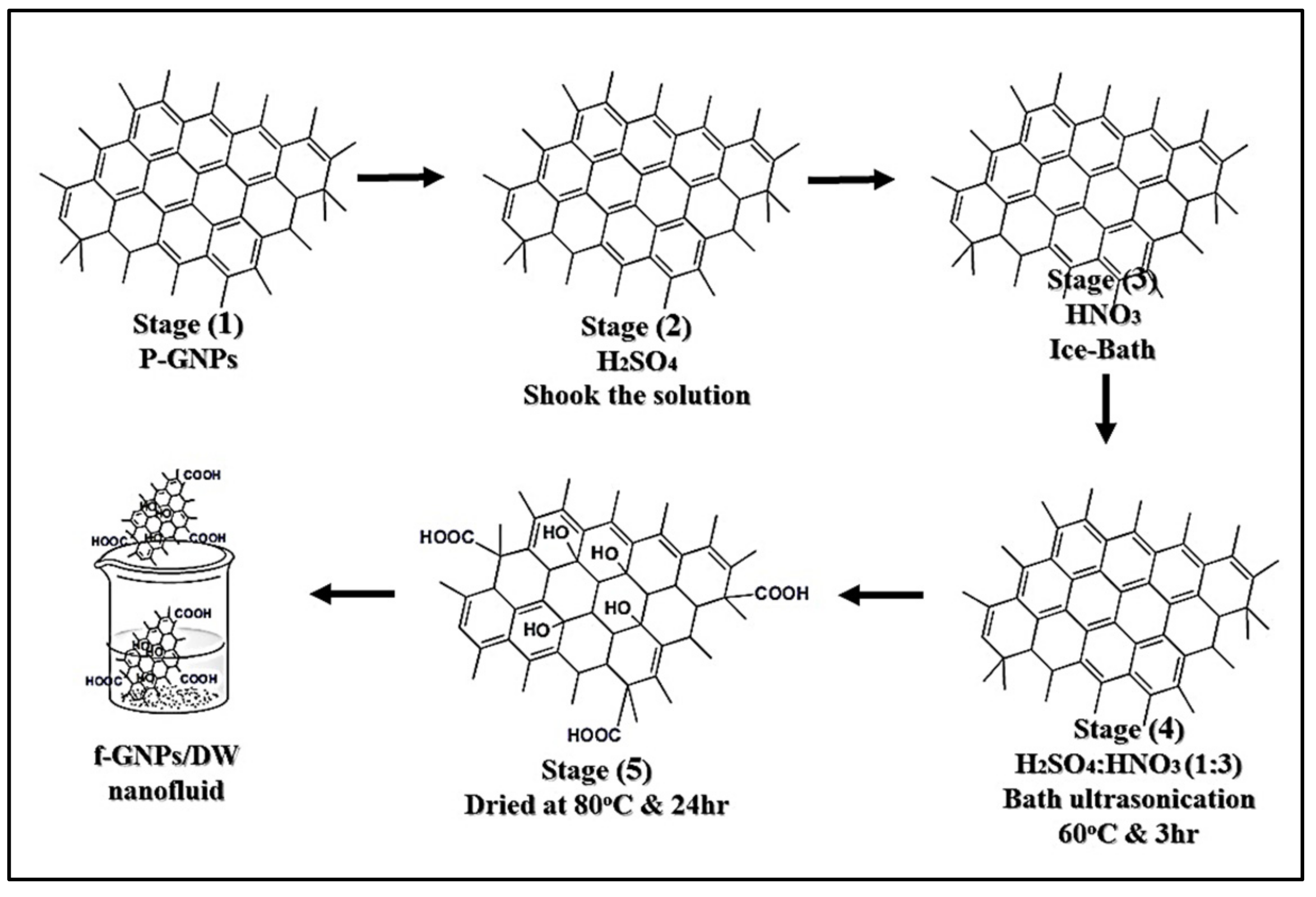
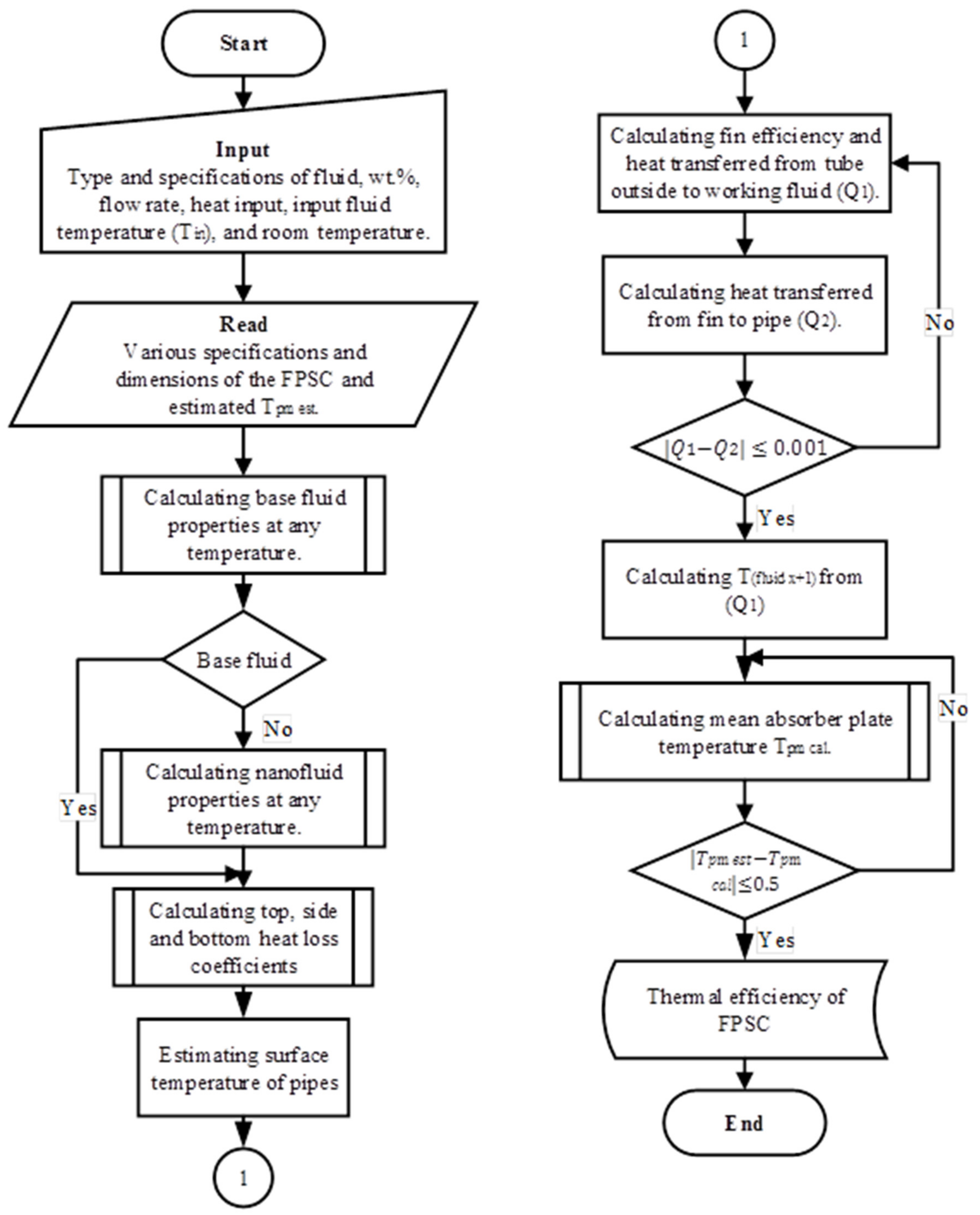

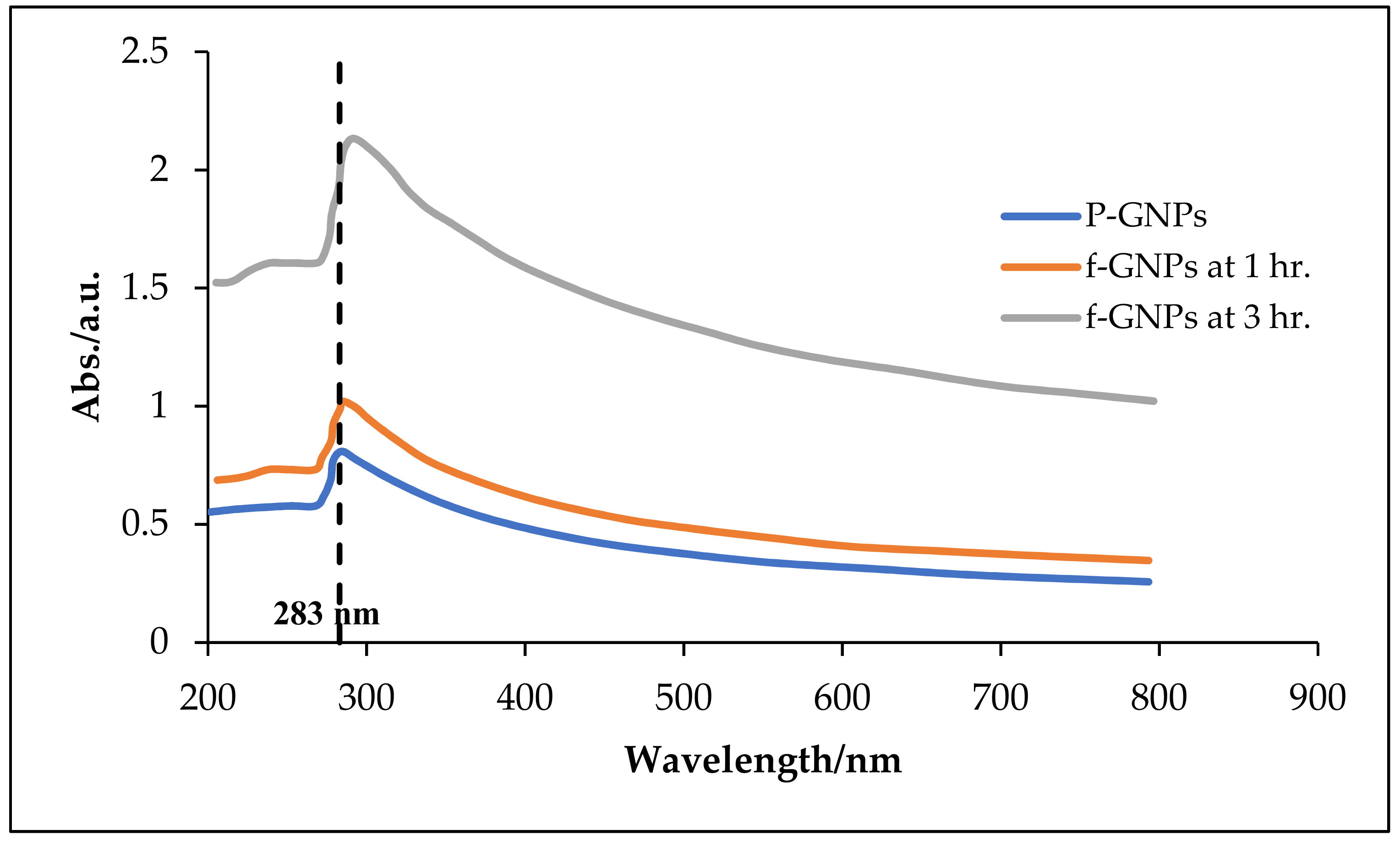
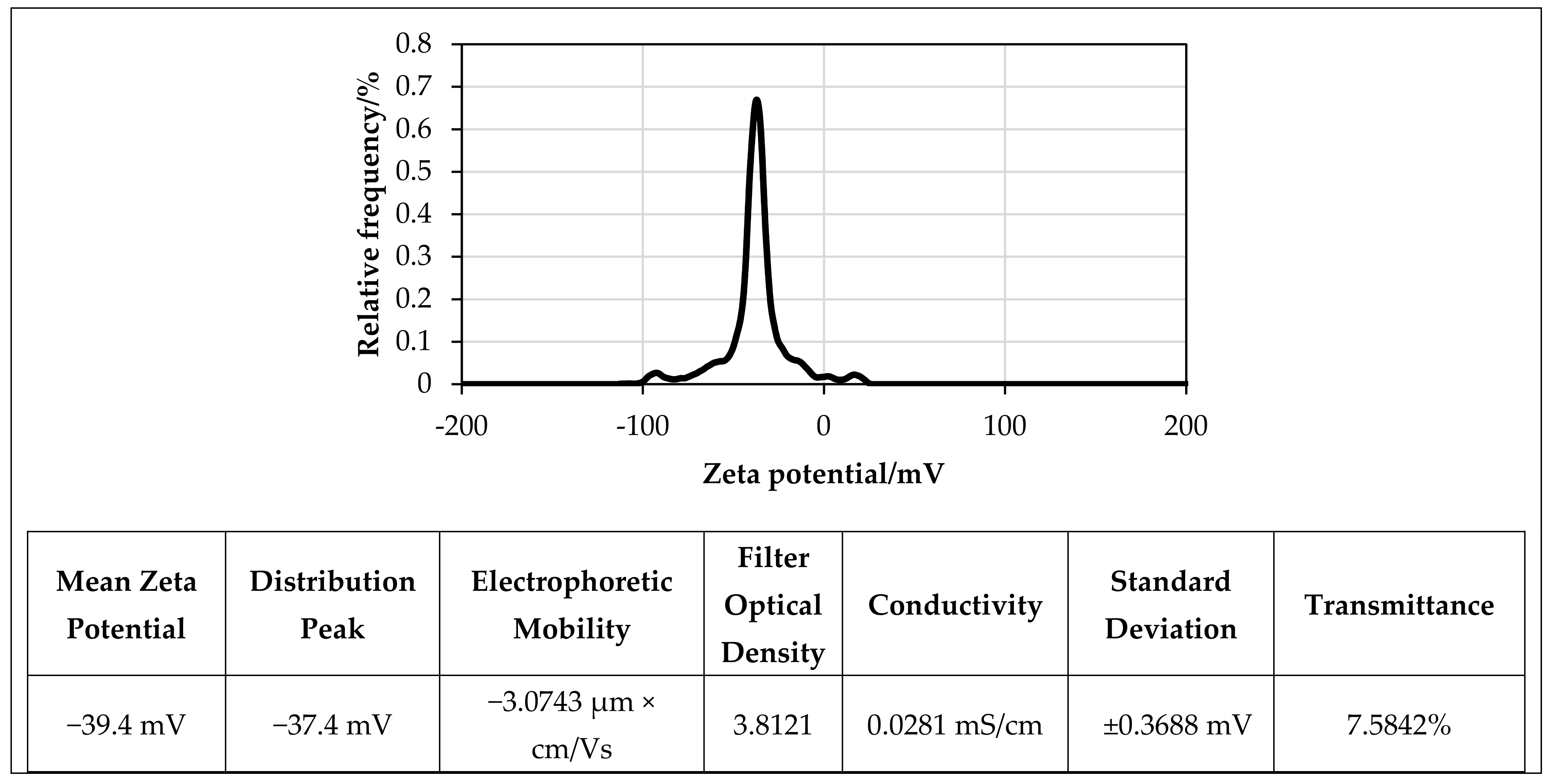


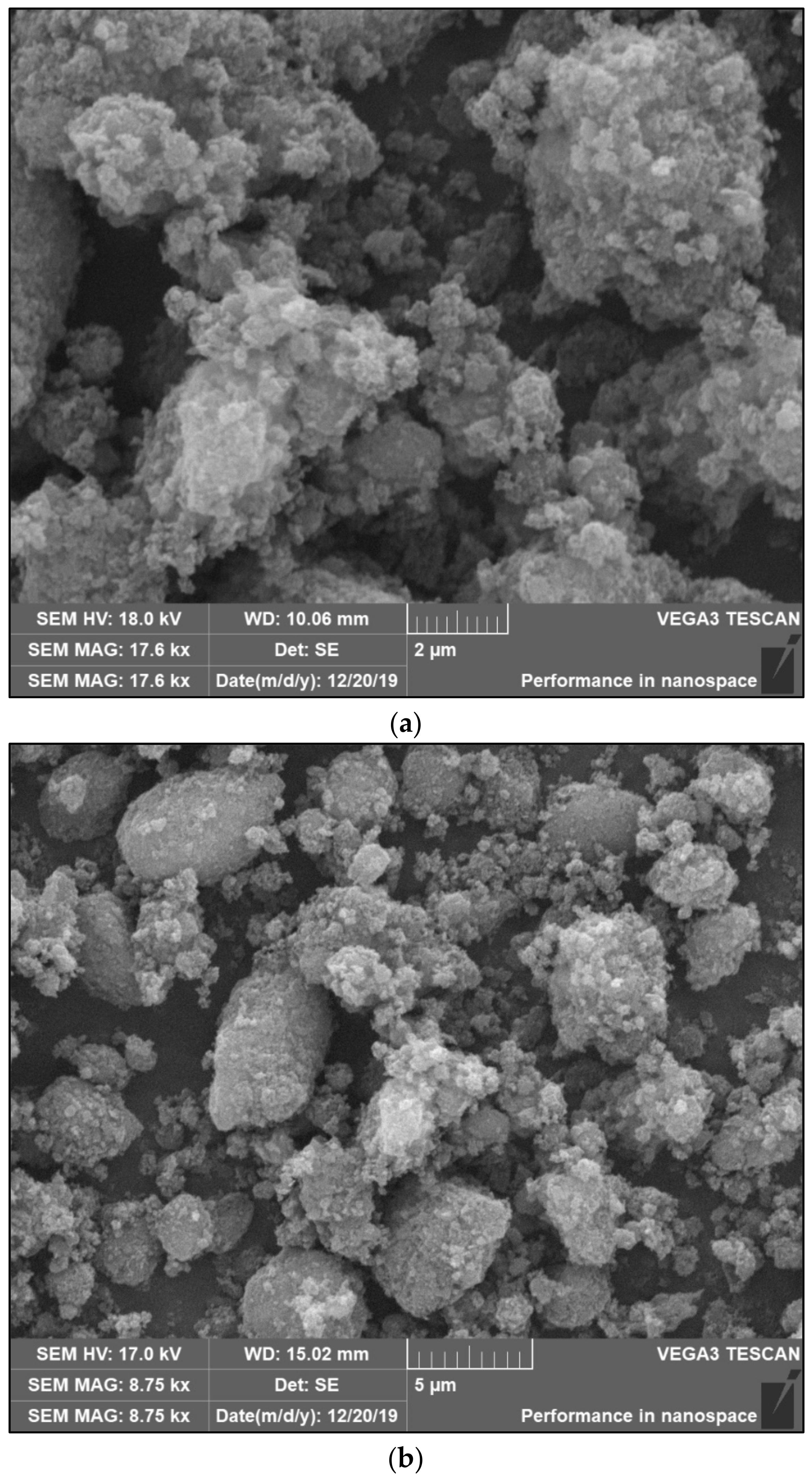
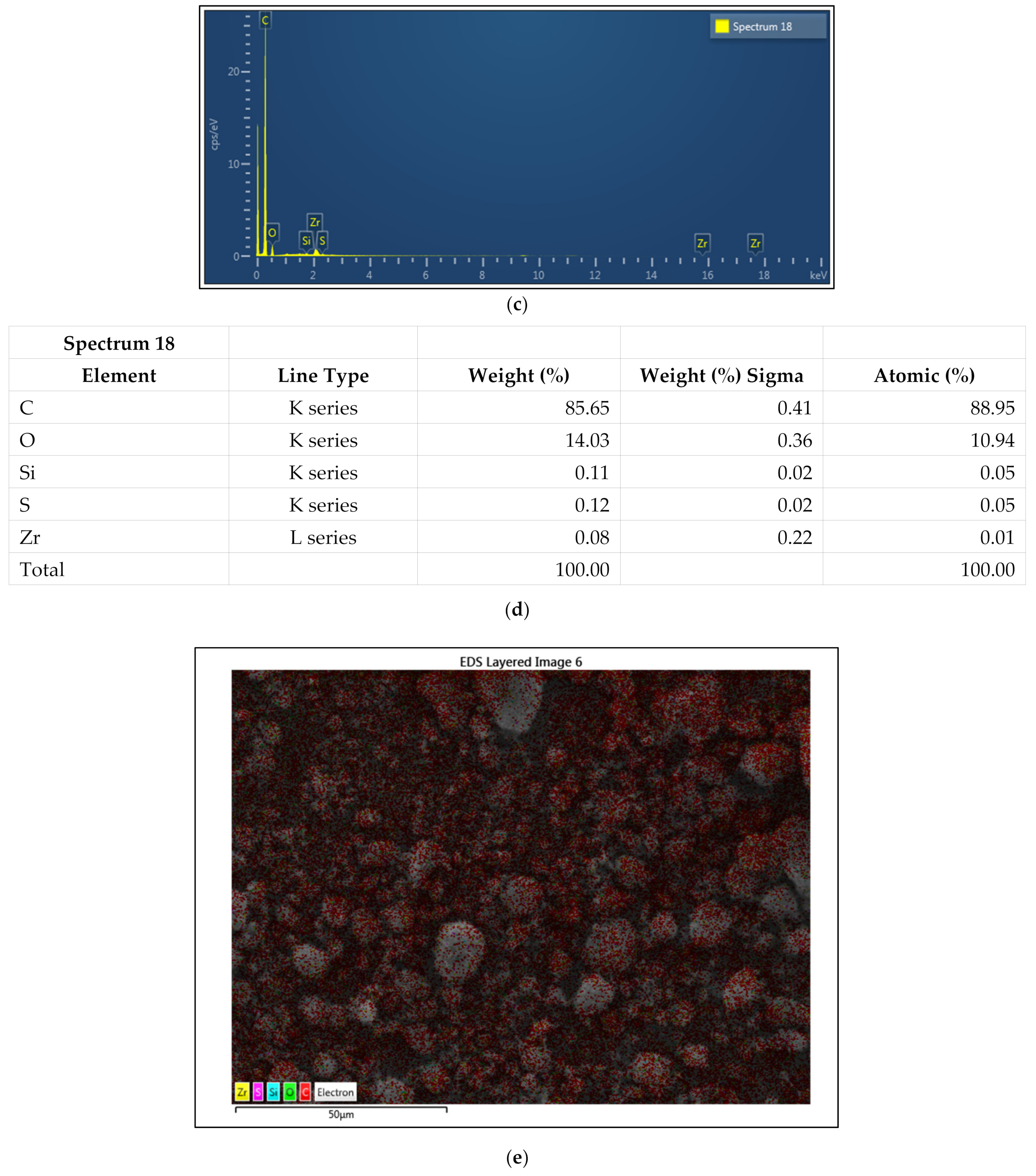

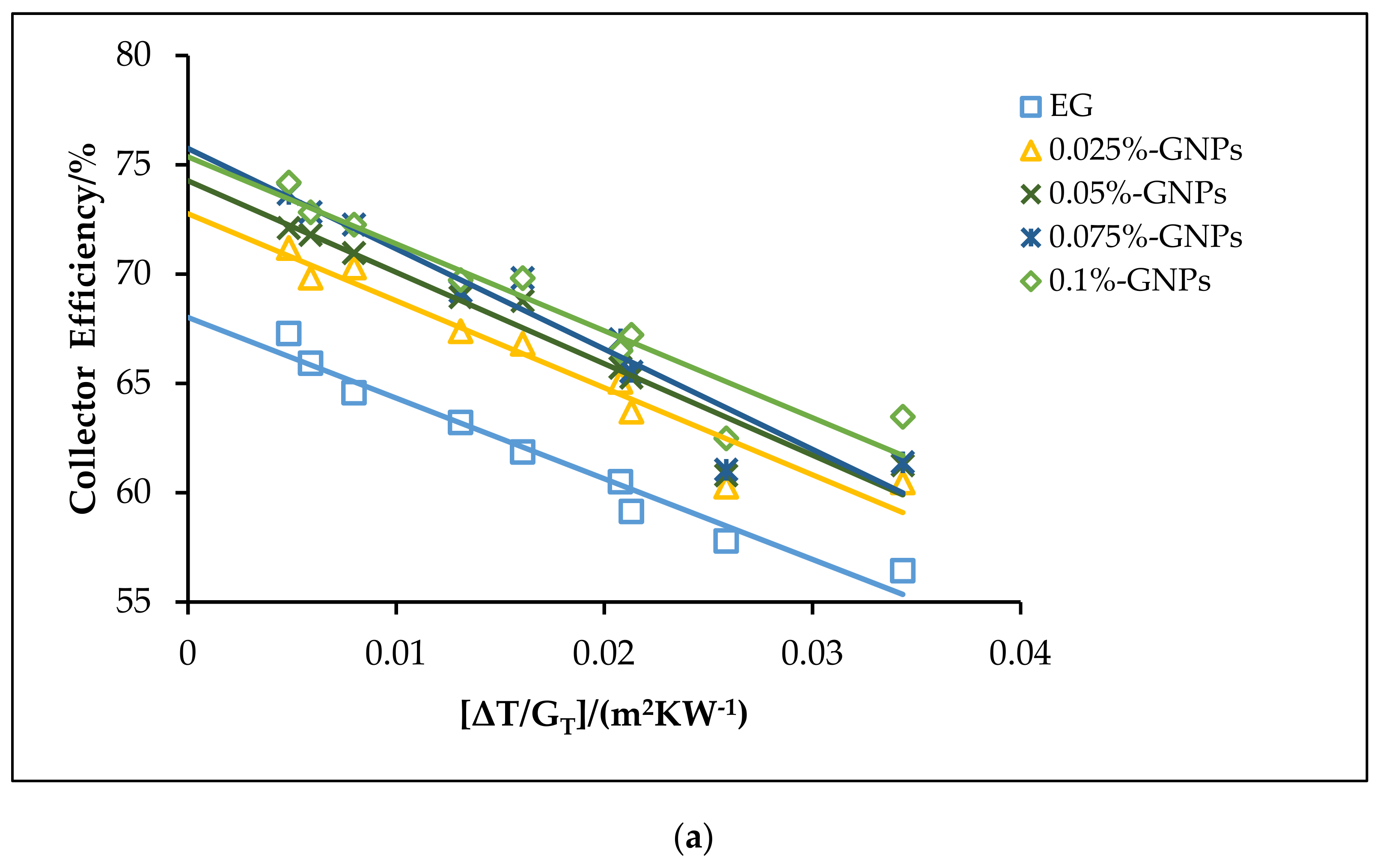
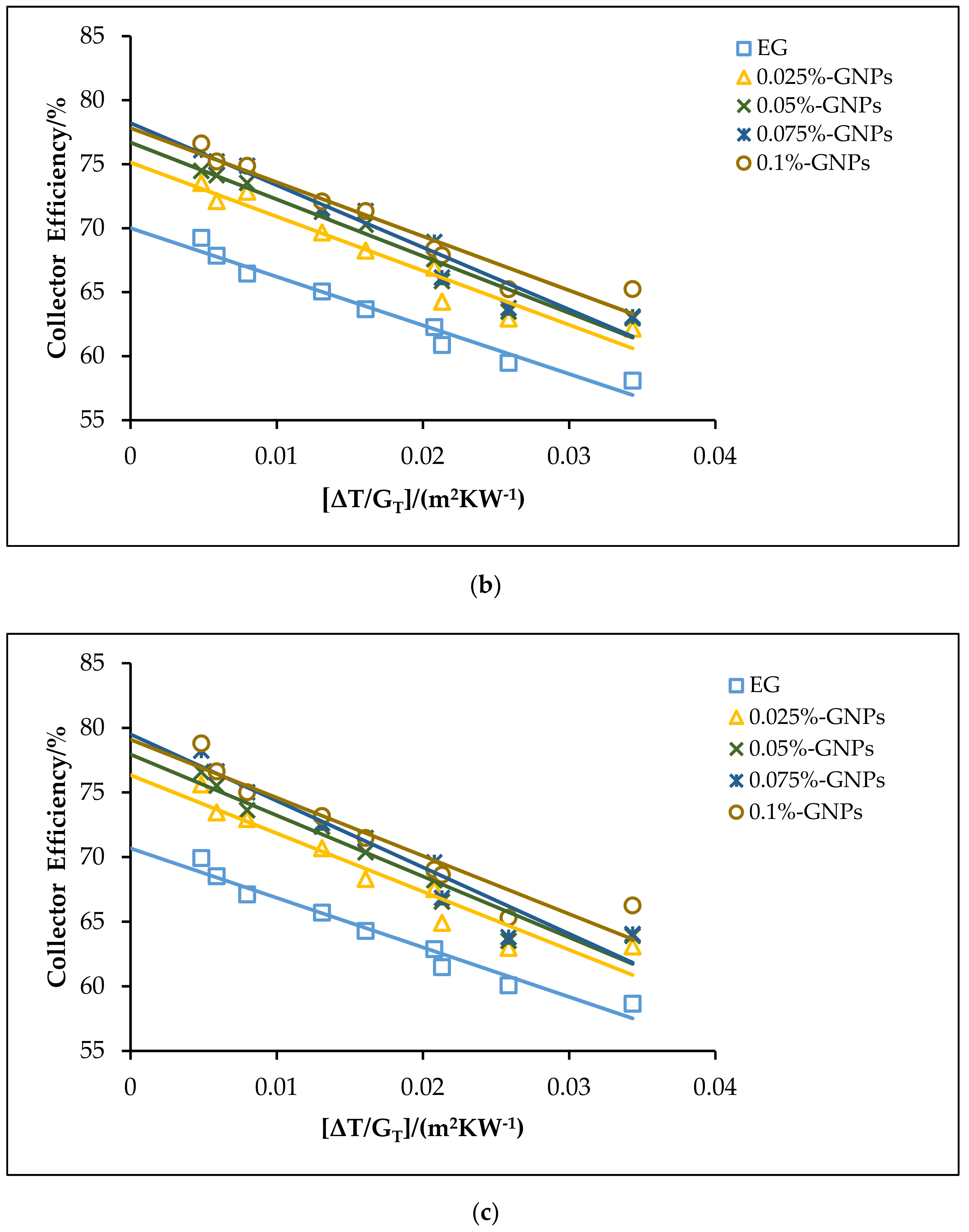
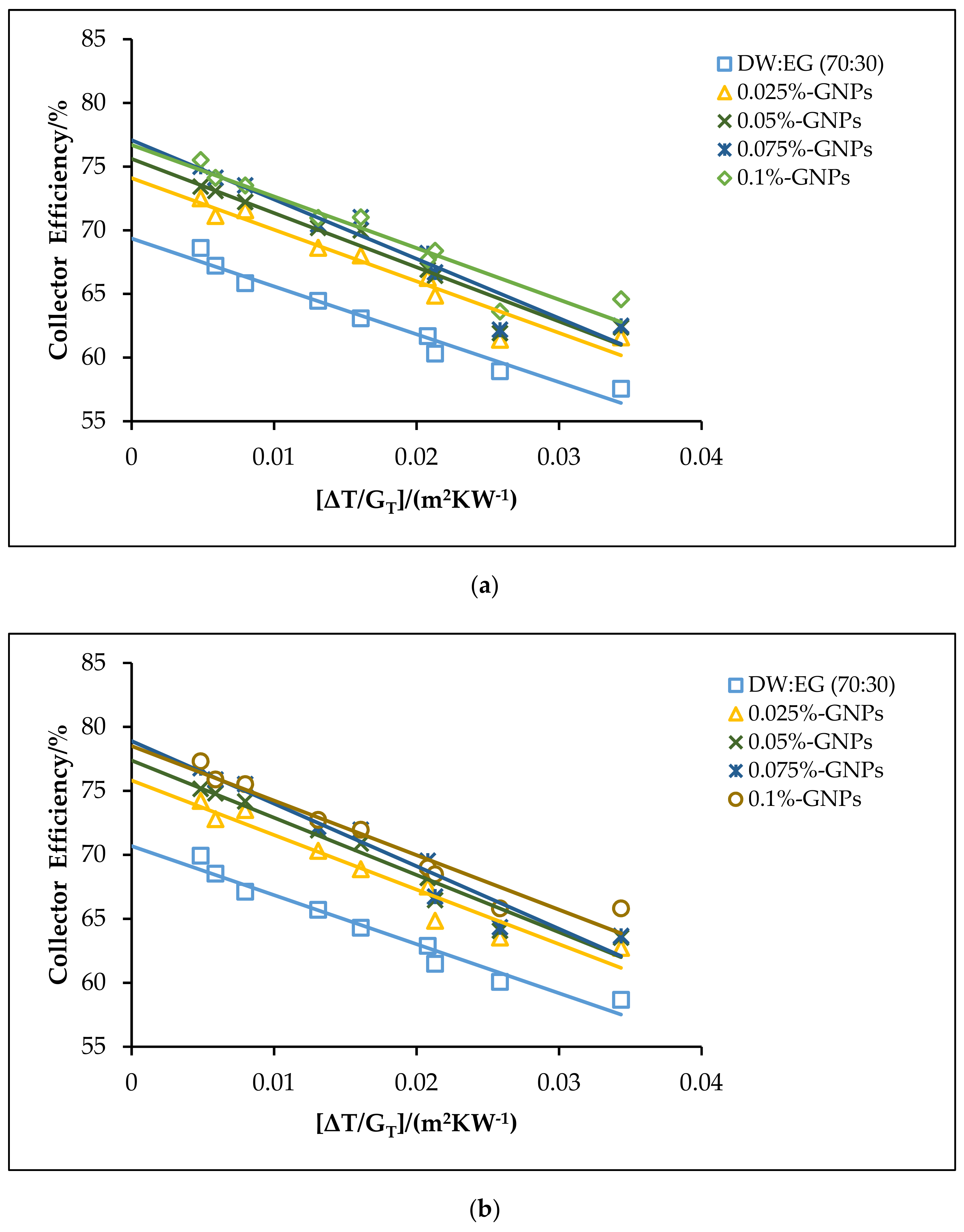
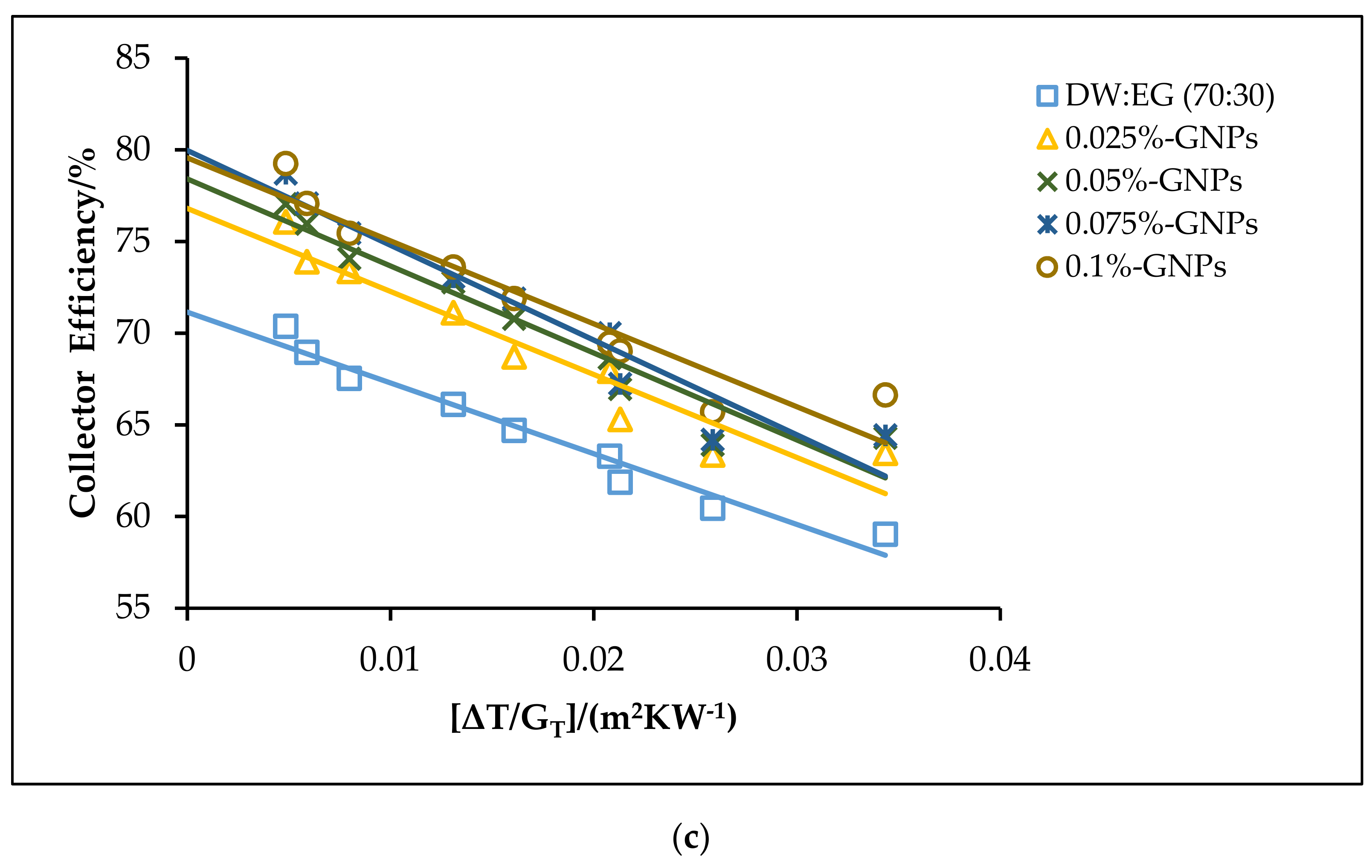
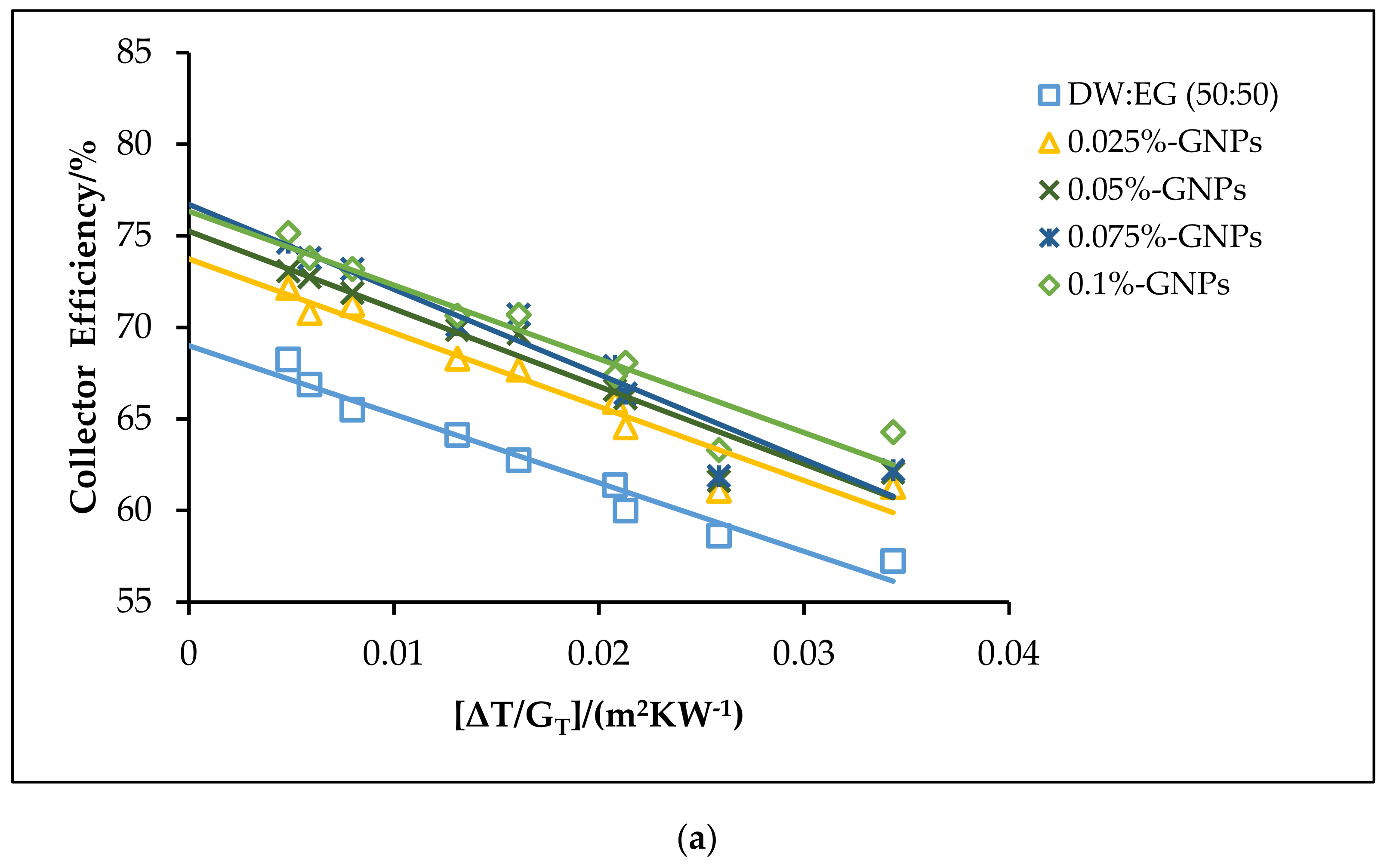
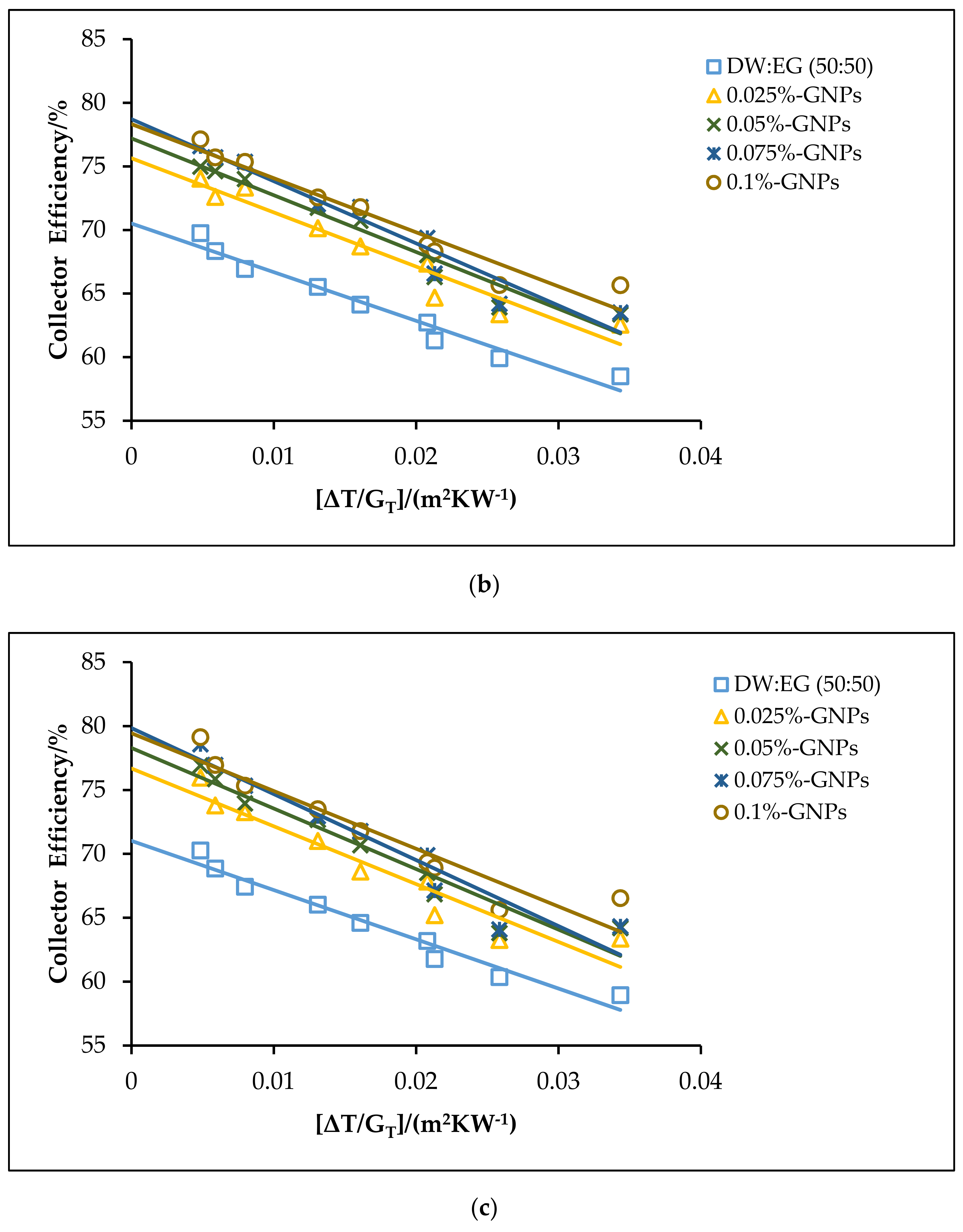
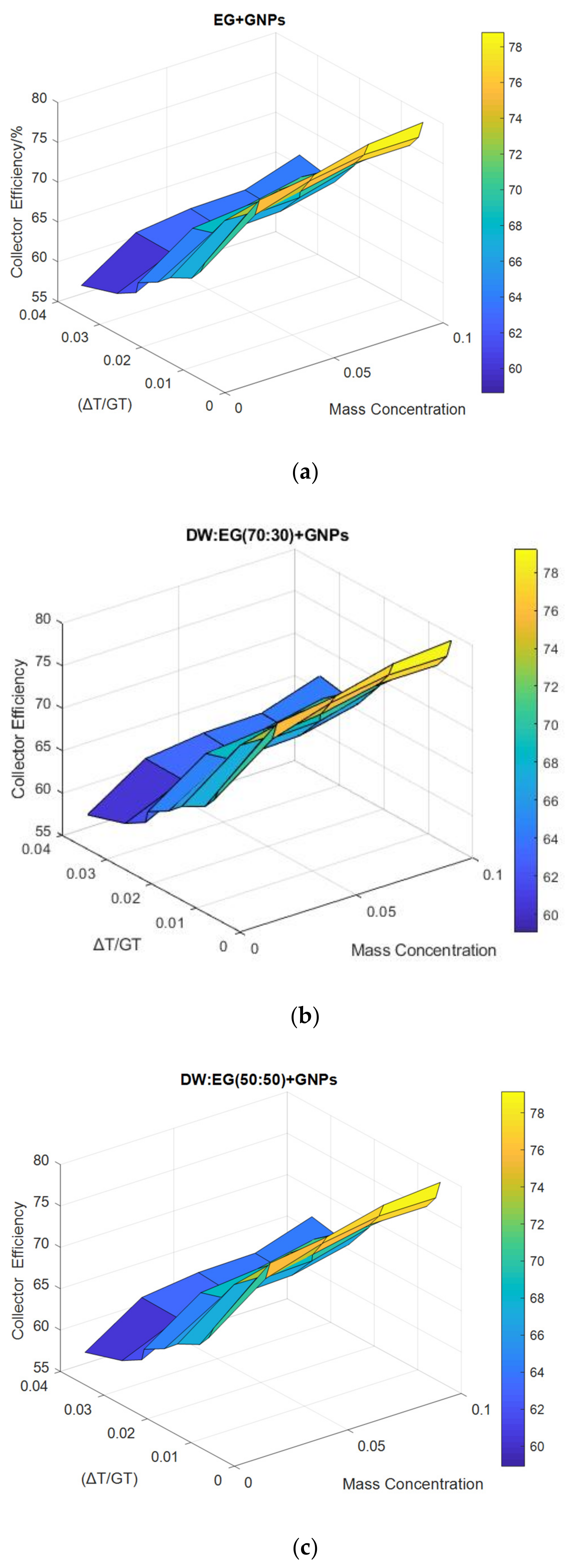
| Specifications | Dimension |
|---|---|
| Collector occupied area | 0.6810 m2 |
| Absorber area | 0.4645 m2 |
| Header tube outer diameter | 22.2 mm |
| Header tube inner diameter | 20.9 mm |
| Riser tube outer diameter | 12.7 mm |
| Riser tube inner diameter | 11.6 mm |
| Transmittance–absorptance product | 0.8772 |
| Tilt angle | 30° |
(kg min−1) | EG | 0.025% f-GNPs | 0.05% f-GNPs | 0.075% f-GNPs | 0.1% f-GNPs | |||||
|---|---|---|---|---|---|---|---|---|---|---|
| FR(τα) | FRUL | FR(τα) | FRUL | FR(τα) | FRUL | FR(τα) | FRUL | FR(τα) | FRUL | |
| 0.5 | 0.6802 | 6.1547 | 0.7276 | 6.6331 | 0.7427 | 6.6384 | 0.7536 | 6.9783 | 0.7574 | 7.6509 |
| 1 | 0.7000 | 6.3315 | 0.7513 | 7.0471 | 0.7669 | 7.0527 | 0.7781 | 7.4035 | 0.7821 | 8.0977 |
| 1.5 | 0.7068 | 6.3930 | 0.7634 | 7.5044 | 0.7794 | 7.5101 | 0.7909 | 7.8702 | 0.795 | 8.5826 |
(kg min−1) | DW:EG (70:30) | 0.025% f-GNPs | 0.05% f-GNPs | 0.075% f-GNPs | 0.1% f-GNPs | |||||
|---|---|---|---|---|---|---|---|---|---|---|
| FR(τα) | FRUL | FR(τα) | FRUL | FR(τα) | FRUL | FR (τα) | FRUL | FR(τα) | FRUL | |
| 0.5 | 0.6935 | 6.2736 | 0.7409 | 6.7520 | 0.7560 | 6.7573 | 0.7669 | 7.0973 | 0.7707 | 7.7698 |
| 1 | 0.7069 | 6.3959 | 0.7582 | 7.1115 | 0.7738 | 7.1171 | 0.785 | 7.4679 | 0.789 | 8.1621 |
| 1.5 | 0.7114 | 6.4376 | 0.7680 | 7.5490 | 0.7841 | 7.5546 | 0.7956 | 7.9148 | 0.7996 | 8.6271 |
(kg min−1) | DW:EG (50:50) | 0.025% f-GNPs | 0.05% f-GNPs | 0.075% f-GNPs | 0.1% f-GNPs | |||||
|---|---|---|---|---|---|---|---|---|---|---|
| FR(τα) | FRUL | FR(τα) | FRUL | FR(τα) | FRUL | FR (τα) | FRUL | FR(τα) | FRUL | |
| 0.5 | 0.6899 | 6.2429 | 0.7373 | 6.7211 | 0.7525 | 6.7266 | 0.7633 | 7.0666 | 0.7672 | 7.7391 |
| 1 | 0.7051 | 6.3817 | 0.7564 | 7.0973 | 0.7720 | 7.1028 | 0.7832 | 7.4536 | 0.7872 | 8.1478 |
| 1.5 | 0.7102 | 6.4251 | 0.7668 | 7.5365 | 0.7828 | 7.5423 | 0.7944 | 7.9022 | 0.7984 | 8.6146 |
Publisher’s Note: MDPI stays neutral with regard to jurisdictional claims in published maps and institutional affiliations. |
© 2021 by the authors. Licensee MDPI, Basel, Switzerland. This article is an open access article distributed under the terms and conditions of the Creative Commons Attribution (CC BY) license (http://creativecommons.org/licenses/by/4.0/).
Share and Cite
Alawi, O.A.; Kamar, H.M.; Mallah, A.R.; Mohammed, H.A.; Sabrudin, M.A.S.; Hussein, O.A.; Kazi, S.N.; Najafi, G. Graphene Nanoplatelets Suspended in Different Basefluids Based Solar Collector: An Experimental and Analytical Study. Processes 2021, 9, 302. https://doi.org/10.3390/pr9020302
Alawi OA, Kamar HM, Mallah AR, Mohammed HA, Sabrudin MAS, Hussein OA, Kazi SN, Najafi G. Graphene Nanoplatelets Suspended in Different Basefluids Based Solar Collector: An Experimental and Analytical Study. Processes. 2021; 9(2):302. https://doi.org/10.3390/pr9020302
Chicago/Turabian StyleAlawi, Omer A., Haslinda Mohamed Kamar, Abdul Rahman Mallah, Hussein A. Mohammed, Mohd Aizad Sazrul Sabrudin, Omar A. Hussein, Salim Newaz Kazi, and Gholamhassan Najafi. 2021. "Graphene Nanoplatelets Suspended in Different Basefluids Based Solar Collector: An Experimental and Analytical Study" Processes 9, no. 2: 302. https://doi.org/10.3390/pr9020302
APA StyleAlawi, O. A., Kamar, H. M., Mallah, A. R., Mohammed, H. A., Sabrudin, M. A. S., Hussein, O. A., Kazi, S. N., & Najafi, G. (2021). Graphene Nanoplatelets Suspended in Different Basefluids Based Solar Collector: An Experimental and Analytical Study. Processes, 9(2), 302. https://doi.org/10.3390/pr9020302










